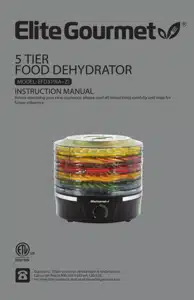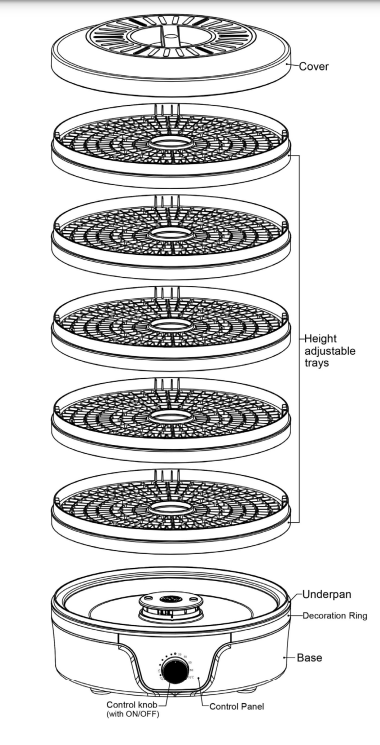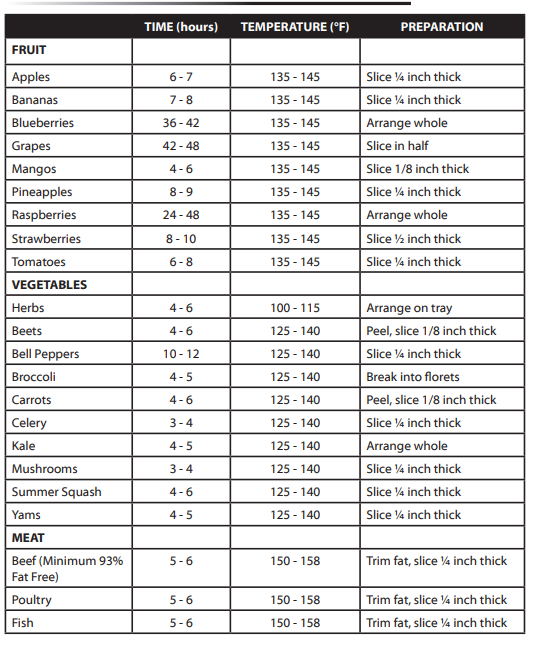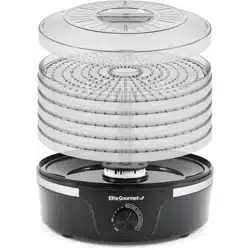Documents: Go to download!
User Manual
- Owner's manual - (English)

- IMPORTANT SAFEGUARDS
- BEFORE FIRST USE
- HOW TO USE
- CLEANING AND MAINTENANCE
- FOOD PACKAGING AND STORAGE
Table of contents
User Gudie Elite Gourmet EFD319 Food Dehydrator
IMPORTANT SAFEGUARDS
POLARIZED PLUG
If an extension cord is used:
(1) the marked electrical rating of the extension cord should be at least as great as the electrical rating of the product;
(2) the extension cord should be arranged so that it will not drape over the counter top or tabletop where it can unintentionally be pulled on or tripped over by children or pets.
Note:
- A short power cord is provided to reduce the risk of personal injury resulting from becoming entangled in or tripping over a long cord.
- Longer power-supply cords or extension cords may be used if care is exercised in their use.
SHORT CORD PURPOSE
- If the plug still does not fit, contact a qualified electrician. Never use the plug with an extension cord unless the plug can be fully inserted into the extension cord.
- Do not alter the plug of the product or any extension cord being used with this product. Do not attempt to defeat the safety purpose of the polarized plug.
- If this appliance is equipped with a polarized plug (one blade is wider than the other), please follow the below instructions:
- To reduce the risk of electrical shock, this plug is intended to fit into a polarized outlet only one way. If you are unable to fit the plug into the electrical outlet, try reversing the plug
PARTS IDENTIFICATION

BEFORE FIRST USE
- Carefully unpack the food dehydrator.
- Wash the five dehydrator trays and lid in warm, soapy water. Rinse well and dry thoroughly.
- Wipe the dehydrator base with a clean, soft cloth or sponge.
- After cleaning, the unit must run in for 30 minutes without placing foods for drying during this period. During the first use, you may detect minimal smoke or odor. This is caused by manufacturing residue and is normal. Please ensure sufficient ventilation. After the running in period, rinse the racks in water and dry all parts. This act is only necessary for the first time.
- Do not clean appliance with aggressive chemicals or abrasives to avoid damaging the surface of the base, lid and drying trays.
ASSEMBLING
- Make sure that the dehydrator sits steadily on a solid, level surface. Stack the drying trays and connect the plug with a wall socket.
- The trays can be stacked with a clearance of 1.4 cm or 2.5 cm, and are therefore adjustable to the thickness of the food to be dehydrated.
TIPS:
- If you stack 2 trays inside each other and you notice that the top tray is touching the food below, move the upper tray to a higher position ( see diagram below).
HOW TO USE
- Make sure unit is OFF and unplugged before using.
- Always wash the dehydrator trays and lid before each use to avoid any food contamination.
- Place base on a flat, smooth countertop surface where it will not fall or be pulled by the plug.
- Prepare food to be dehydrated as instructed in this manual; preparation depends on the type of food. Do not overlap food or overload trays.
- Arrange food on trays, but do not place trays on the base; stack up the trays first and set them aside.
- Plug unit into electrical wall outlet, turn ON and set to desired temperature by turning the control knob clockwise.
- Place stacked trays onto the base, cover the top tray with the lid, and allow food to dry for the recommended length of time; drying time may vary depending on the type of food.
- Begin to check on food before the dehydration period is completed; check food for desired dryness. Remove individual pieces and store in containers or food bags. If some pieces are not yet done, leave them on the dehydrator and check frequently until all food dehydration is completed.
- Turn the unit OFF and unplug after using.
- Always wash the dehydrator trays and lid after each use.
- Wipe the base with a soft damp cloth or sponge; do not allow water or any other liquid to get into the base. Make sure the trays and lid are completely dry before replacing them on the base.
NOTE:
- Always start to load the food from the bottom tray to the top tray.
- It is recommended to stack at least 3 working trays, whether you have food on them or not.
- Set low temperature for thin/small pieces of food or for a small load of food. Set high temperature for drying thick/big pieces of food and large loads. T
- he thermostat can also be used to decrease the temperature as the food is near the end of its drying cycle making it easier to control the final moisture level in the food.
- Use 93% fat free when dehydrating red meats to ensure longer life for dehydrator trays.
- Additionally, hand wash trays & lid with warm soapy water.
FOOD DEHYDRATING GUIDE
- Depending on the moisture in the food itself and the humidity in the air, dehydrating operation time can vary.
- Use the dehydrator in a dust free, well-ventilated, warm and dry room.
- Do not use the dehydrator outdoors.
- Fruit and vegetables dried in your food dehydrator will be different in appearance from those sold in health food stores and supermarkets. This is due to your food dehydrator uses no preservatives, no artificial coloring and only natural additives.
- One easy way to determine if food is dried is to place a piece in a small zipper seal plastic bag. Seal the bag and shake it lightly. If moisture appears, the food is not ready to be removed.
SELECTING THE TYPE OF FOOD TO DEHYDRATE:
- Food to be dried should be in good condition. Select fruits that are just ripe; they have the highest natural form of sugar and are best for dehydrating.
- Fruits that are not ripe may have a flat, bitter taste.
- Vegetables should be fresh and tender.
- Check fruits and vegetables for marks or bruises and cut away these portions before preparing for dehydration.
- Avoid using overripe fruits and vegetables with spoiled portions.
- Meat (minimum 93% fat free), poultry and fish should be fresh and lean.
- Preparation, dehydration time and storage of foods also influence their quality and taste. Follow the preparation, dehydration and storage instructions in this manual to ensure the best-quality dried foods.
WARNING:
- If you suspect food is contaminated, freeze at 0° for 48 hours to prevent bacteria growth, or heat at 175°F for 15 minutes to pasteurize it. Some nutrition may be lost, but it will stop the contamination process.
VEGETABLES:
- Vegetables dried at home require a little more effort in processing and storage than do fruits because they are low in acid and have little sugar.
- Some vegetables have a poor quality when dehydrated and are better frozen than dried. Others, such as potatoes, are available at reasonable prices all year round, and it may not be worth your time to dry them unless they are used for lightweight camping. Be selective in the vegetables you choose to dry.
Preparation:
- Select only the highest quality, most fresh, crisp and tender vegetables for dehydrating.
- Wash vegetables carefully and thoroughly before dehydrating to remove any dirt and bacteria.
- Most vegetables should be peeled, trimmed, cut, or shredded prior to dehydrating.
Steam Blanching:
- Layer prepared vegetables in the top portion of a food steamer, no more than 2 to 2 ½ inches deep.
- Steam until vegetables are heated all the way through but are not cooked enough to eat (usually 2 to 3 minutes). Small pieces may need occasional stirring to steam blanch evenly.
- Transfer steamed vegetables directly to dehydrating trays, working as quickly as possible.
Microwave Blanching:
- Microwave ovens are convenient for blanching fresh vegetables.
- Prepare vegetables for steam blanching by placing vegetables with a small amount of water (refer to your microwave oven cooking chart) in a covered casserole dish.
- Cook for only ¼ to 1/3 the time specified in the chart, stirring well after half of the blanching time.
- Transfer blanched vegetables directly to dehydrating trays, working as quickly as possible.
DEHYDRATING TIPS:
- Dehydrating time for pre-treated fruit will vary according to the following factors:
- Thickness of fruit pieces or slices
- Number of trays with food being dried
- Volume of food being dried
- Moisture or humidity in your environment
- Your preference of dehydrating for each type of dried food
It is recommended to:
- Check your food frequently every hour during the dehydrating cycle.
- Label food with the name of food contents, date and weight before dehydrating. It will also be helpful to note the dehydrating time for future reference.
- Blanched vegetables & fruits will give the best results in dehydrating.
- Correct food storage after dehydrating
Pretreatment Methods:
- It is not necessary to always pre-treat food in order to dehydrate it. However, pretreatment often makes food look better, increases the shelf life and can even enhance the nutritional value of some fo
- Experiment with both treated and untreated food in your storage to see which will best suit your needs. Proper storage is critical to the quality of the stored product, whether treated or untreated.
Natural Pre-Dips:
- Use pineapple or lemon juice as a natural alternative to reduce browning. Slice fruit directly into juice. Remove promptly (about 2 minutes) and place on dehydrating trays.
- Fruits may also be dipped in honey, spices, lime or orange juice, jello powders or sprinkled with shredded coconut to give them a snappy dried flavor. Use your imagination and make your own dip.
Sodium Bisulfate:
- Ask for food-safe, (USP) grade only. Dissolve 1 teaspoon of sodium bisulfate in one quart of water. Prepare small amounts of fruit and dip for 2 minutes in the solution.
- This helps prevent loss of vitamin C and maintains a bright color. Sodium bisulfate is available in most pharmacy/drug stores.
Popping Backs:
- When dehydrating fruit halves, especially apricots, it has been suggested that popping the back (“inside out”) will speed the dehydrating time.
- This is true, but it also results in the loss of the nutritional juices to the bottom of the dehydrator. Instead, cut each half in half again to give the end product more nutritional value, a brighter color, and faster reconstitution capabilities.
MEAT DEHYDRATING PREPARATION:
- The United States Department of Agriculture recommends meat be precooked prior to or cooked after dehydrating to reduce the risk of food borne illnesses.
- Normally raw meat is used for making jerky. However, cooked meat as well as raw meat can be dehydrated. Make sure to always cut meat down to bite size before dehydration. It is much easier to work with beforehand.
- Be extra careful when making jerky from raw chicken or turkey; salmonella bacteria may be present in poultry when it is purchased. It is extremely important to cut raw chicken or turkey into portions that do not exceed 1/4” thickness.
- Any marinade must soak into the meat at least 10 minutes. It is not recommended to remove any excess marinade sauce. Never consume food that tastes, smells or looks improper.
Raw Meat For Beef Jerky:
- Only use meat that is at least 93% fat-free to make jerky. Make sure to trim off all the fat before slicing into bite-size portions. It is recommended to slice meat about 1/8” - 1/4” thickness.
NOTE:
- For best results, we recommend using red meats (minimum 93% fat free). This will result in longer life for your dehydrating trays. Additionally, hand wash trays with warm soapy water immediately after use & trays have cooled.
- Marinating beef has many different combination recipes. Please see some recipe samples below for your preference:
- Traditional Jerky: (Good for approximately 3-5 lbs of beef, fish, or poultry) lb brown sugar cups soy sauce
- Mix all ingredients together. Make sure the brown sugar is dissolved. Let mixture sit for approximately 15 minutes. Place cut up meat into the marinade and cover. Let stand for 10 minutes refrigerated. Make sure to turn meats periodically to coat thoroughly. Drain any excess liquid.
- Place meats onto trays and dehydrate. Dehydrating time for a full 5-tray set up will take approximately 5-6 hours.
NUTS:
- Remove shells to the nuts and rinse nuts with warm water. Pat dry and spread on trays. Most nuts will take approximately 20-30 hours to dehydrate; they should be allowed to dehydrate until brittle.
- After dehydrating, allow to cool. Nuts that will not be consumed within a day or two should be frozen to ensure freshness. Remove nuts from the freezer and allow them to defrost before using.
FLOWERS:
- For best results, pick flowers after the morning dew rises and before the evening mist sets in. Do not use flowers that have been sprayed with insecticides or other chemicals.
- If dehydrating at the same time as herbs intended for consumption, place flowers on bottom trays and herbs on top trays; this is to prevent any “drippings” from the flowers to fall onto the herbs.
CLEANING AND MAINTENANCE
TO CLEAN:
- Always allow the dehydrator to cool completely before cleaning.
- Unplug the dehydrator before cleaning.
- After each use, clean and dry the dehydrating trays and lid in warm, soapy water. NOTE: After dehydrating red meats, hand wash trays with warm soapy water immediately after dehydrating and after the unit has cooled.
- Use a damp cloth to clean the dehydrator base.
- Do not immerse the dehydrator in water. Use nonabrasive cleaners or soft soap only.
TO STORE:
- Unplug unit; store in its box in a clean, dry place. Never store it while it is hot or still plugged in. Never wrap cord tightly around the appliance.
- Do not put any stress on the cord where it enters the unit, as it could cause the cord to fray and break.
DEHYDRATING TIME & TEMP CHART

FOOD PACKAGING AND STORAGE
- Dried foods need to be properly packaged to prevent re-absorption of moisture and microbial deterioration. Pack food in clean, dry, airtight containers. Glass jars or freezer containers with tight-fitting lids are good for storage. Re-sealable plastic freezer bags are also acceptable.
- Store packaged dried food in a dry, cool location away from light. Higher temperatures and exposure to light will shorten the storage time and result in loss of quality and nutrients.
- Most dried fruit, when properly packaged and stored, will be good for 1 year at 60°F or 6 months at 80°F. Fruit leather/rolls should keep for up to 1 month at room temperature. Vegetables have about half the storage life as fruit. If food is to be kept longer, then store it in a freezer.
- Package vegetables and fruits in separate containers to avoid flavor transfer.
DRIED FOODS MUST BE PROPERLY PACKAGED IN ORDER TO KEEP WELL.
- Package your dried foods in freezer plastic bags, squeezing out as much air as possible. Heat-sealable bags may also be used.
- Store the plastic bags inside of airtight metal, plastic or glass containers. Storing foods in rigid containers without first putting them into the freezer bags exposes the dried foods to air. Vacuum packaging equipment for home use is available in some stores around the country.
- Vacuum packaging will greatly extend shelf life.
Storage Conditions:
- Store properly packaged dried foods in a cool, dark place. The cooler the food is kept, the longer the optimal quality will be maintained.
- For every 18°F drop in temperature, the shelf life increases 2 to 3 times. If you have room in a refrigerator or freezer, keep your dried foods there.
- Otherwise, find the coolest place in your home to store dried foods. Light also causes the quality and nutritive value to deteriorate. Keep dried foods in the dark or in opaque containers.
Shelf Life:
- Fruits have a naturally high sugar and acid content, which allows them to dry well and store for longer periods of time than vegetables.
- When properly packaged and stored at room temperature or below (70°F or less), most fruits will maintain a high quality and nutritional value up to a year. Most vegetables are best when eaten within six months.
See other models: EBK8806BL EBK8810BL EHD-051B EFS-400 EAF5002N

